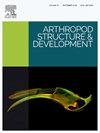Fine structure of the posterior midgut in the mite Anystis baccarum (L.).
IF 1.7
3区 农林科学
Q2 ENTOMOLOGY
引用次数: 1
Abstract
Homology of the posterior midgut regions (PMG) in different phylogenetic lineages of acariform mites (superorder Acariformes) remains unresolved. In the order Trombidiformes, the ultrastructure of the PMG is known primarily in derived groups; thus this study focuses on species belonging to a relatively basal trombidiform family. PMG of Anystis baccarum consists of the colon and postcolon separated by a small intercolon. The fine structure of the colon and postcolon is close to that of the corresponding organs of sarcoptiform mites with the epithelium showing absorptive and endocytotic activity. The epithelial cells produce a variety of excretory vacuoles and a peritrophic matrix around the feces. Morover, the epithelium of the postcolon is characterized by the highest apical brush border and especially numerous mitochondria suggesting involvement in water and ion absorption. The intercolon functions as a sphincter lined with an epithelium capable of producing excretory granules. A pair of short blind extensions arises assimmetrically from the intercolon into the body cavity. Ultrastructurally, these extensions are similar to the arachnid Malpighian tubules and may be their reduced version. Rare endocrine-like cells have been observed in the colon and postcolon.bacaccarum (L.)螨后中肠精细结构。
棘螨(超目棘螨目)不同系统发育谱系的后中肠区(PMG)同源性尚不清楚。在原形目中,PMG的超微结构主要在衍生群中已知;因此,本研究的重点是属于相对基础的恙螨科的物种。双歧杆菌的PMG由结肠和结肠后组成,由一个小的结肠间分隔。结肠和结肠后的精细结构与肉仿螨的相应器官相似,上皮具有吸收和内吞活性。上皮细胞产生各种排泄液泡和粪便周围的营养基质。此外,结肠后上皮的特点是最高的顶端刷状边界,特别是大量的线粒体,表明参与了水和离子的吸收。结肠间具有括约肌的功能,括约肌内衬有能够产生排泄颗粒的上皮。从结肠间到体腔有一对不对称的短而盲的延伸。在超微结构上,这些延伸与蛛形动物的马氏小管相似,可能是它们的简化版本。在结肠和结肠后发现了罕见的内分泌样细胞。
本文章由计算机程序翻译,如有差异,请以英文原文为准。
求助全文
约1分钟内获得全文
求助全文
来源期刊
CiteScore
3.50
自引率
10.00%
发文量
54
审稿时长
60 days
期刊介绍:
Arthropod Structure & Development is a Journal of Arthropod Structural Biology, Development, and Functional Morphology; it considers manuscripts that deal with micro- and neuroanatomy, development, biomechanics, organogenesis in particular under comparative and evolutionary aspects but not merely taxonomic papers. The aim of the journal is to publish papers in the areas of functional and comparative anatomy and development, with an emphasis on the role of cellular organization in organ function. The journal will also publish papers on organogenisis, embryonic and postembryonic development, and organ or tissue regeneration and repair. Manuscripts dealing with comparative and evolutionary aspects of microanatomy and development are encouraged.

 求助内容:
求助内容: 应助结果提醒方式:
应助结果提醒方式:


